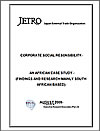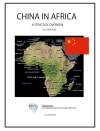 Ethiopian Airlines
Ethiopian Airlines
All data are collected in the Fiscal Year of 2008-2009.
Company Profile and History
Ethiopian Airlines (“Ethiopian”) is the national airline of Ethiopia with its main hub at Bole International Airport. During the past sixty plus years, the airline has become one of the continent’s leading carriers, unrivalled in Africa for efficiency and operational success, turning profits for almost all the years of its existence. It has also become one of Ethiopia’s major industries. Ethiopian Airlines serves 53 international destinations with 157 weekly international departures from Addis Ababa and a total of 410 weekly international departures worldwide.
Ethiopian Airlines was founded on December 30, 1945, by Emperor Haile Selassie with assistance from TWA. It commenced operations on April 8, 1946, with a weekly service between Addis Ababa and Cairo with five Douglas DC-3 propeller-driven aircraft. The airline started long-haul services to Frankfurt in 1958 and inaugurated its first jet service in January 1963 from Addis Ababa to Nairobi. In the early 1960s it provided some initial aviation support to the Ethiopia-United States Mapping Mission in its operation to provide topographic maps of Ethiopia.
Although it relied on American pilots and technicians at the beginning, by its 25th anniversary in 1971 Ethiopian Airlines was managed and staffed by Ethiopian personnel. In 1998, it started transatlantic services. In 2007, Ethiopia Airlines provided basic pilot and aviation maintenance training to trainees from African countries including Rwanda, Tanzania, Chad, Djibouti, Madagascar and Sudan. Other training was given to employees of Kenya Airways, Air Zimbabwe, Bellview Airlines, Cape Verde Airlines and Air Madagascar.
Ethiopian Airlines has code share agreements with: South African Airways, Lufthansa, TAAG-Angola Airlines, Gulf Air, Air One, Brussels Airlines, British Midland (BMI), Rwanda Air, and Saudi Arabian Airways.
Ethiopian has an advanced maintenance base, which is fully operational for Airframe maintenance up to D-Checks, Engine, Overhaul, Components repair & overhaul, Light Aircraft maintenance and technical, and management assistance for other airlines. The maintenance base is certified by the US- Federal Aviation Administration (FAA).
Ethiopian is self-sufficient in all aviation training systems. The Ethiopian Aviation Academy offers training for Pilots, Aircraft Technicians, Cabin Crew (Service Trainee), Marketing & Sales as well as Management and Finance staff.
Ethiopian Airlines was presented with the prestigious 2008 "Best Airline in Africa Award" at the African Travel Award gala, organised by the Akwaaba Travel Market in Lagos, Nigeria on October 25, 2008. The award was conferred to Ethiopian for its “excellent network and convenient connections in Africa.” Akwaaba Travel Market is the only international travel exhibition in West Africa recognized by the United Nations World Tourism Organization (UNWTO). It is organized annually by African Travel Quarter (ATQ) magazine, the first international travel magazine in West Africa. Akwaaba Travel Market is the African equivalent of the World famous World Travel Market in London and the International Travel Market in Berlin.
In addition to the latest award, Ethiopian won the 2008 corporate achievement award in Johannesburg in August 2008 given by the Aviation and Allied Business Publication for recognition of excellence in the airline industry and Brussels Airport Award for long haul services on October 23, 2008. Ethiopian was the first African carrier to win the 2008 Brussels Airport Company Award.
In Country Location
Bole International Airport, Addis Ababa, Ethiopia: Tel: (+ 251) 11 665 2222; Fax: (+ 251) 11 661 1474
Services and Products
It operates scheduled international passenger and freight services to over 50 destinations worldwide, as well as domestic services to 32 destinations and passenger and cargo charter flights. Ethiopian Airlines operates the Youngest Fleet in Africa. The following are the major categories of owned and leased aircrafts (36 aircraft): 10 Boeing 767-300; 8 Boeing 757-200; 2 Boeing 757-260 F; 2 Boeing 747F; 2 MD-11F; 5 Boeing 737-700NG; 2 B737-800W; and 5 Fokker 50.
Number of Employees
4,850 employees
Financial Information
For the fiscal year 2008/2009, Ethiopia transported 2.8 million passengers (a 12.3 percent increase y/y) generated 12.2 billion birr in revenue (US$ 980 million - a 32.8 percent increase y/y) with a net profit of 1.345 billion birr (108 million US$-a 165 percent increase over the previous year). In the same period, Ethiopian hauled 101 thousand tons of cargo, a 38.4 percent increase over the previous year. These results are the best yet for the 64 year old airliner, and were attributed to an aggressive marketing campaign and major cost cutting measures.
Market Share
Ethiopian Airlines is the fourth largest airline in Africa by passengers and destinations.
Business Objective
“To achieve market leadership by 2010 as a World Class African Airline”
Business Model
Analysts agree that it is unusual to find a business in Africa that is 100% owned by its government actually thriving. Even though the Ethiopian government holds complete ownership of the business, the airline continues to excel, turning profits for almost all the years of its existence. Its success as a government run operation is largely based on the fact that the government does not interfere and the airline’s management is allowed to operate independently. Ethiopian Airlines also invests in promoting Ethiopian culture and tourism, more than the government does, covering 25 percent of the budget for trade fairs and tour operations.
Ethiopian Airlines' own stated strategic plans for 2010 include reaching a revenue target of US$1billion, increasing its fleet to 30 jet aircraft, increasing its international destinations to 60, further expansion of its training and cargo services, the construction of a new catering building and a four-star hotel, expanding the Ethiopian Aviation Academy and installing a B787 simulator.
“Ethiopian renewed and revitalized its strategies during 2008 to improve the route network in order to meet the needs of its customers. Kuwait and Zanzibar were among those routes included to strengthen and reinvigorate the route network. The company also concluded new codeshare agreements with Lufthansa, Brussels Airlines, Gulf Air and Air One respectively. The agreement with Lufthansa permitted the establishment of codeshare partnership between Addis Ababa and Frankfurt and allowed both Ethiopian and Lufthansa to expand and streamline their services. In a similar venture, the partnership between Ethiopian and Brussels Airlines, Gulf Air and Air One opened greater access to each other’s markets to provide relative ease and flexibility in customer service. These codeshare arrangements have created better and wider range of choices for the customers of the carriers involved. In addition to improving passenger convenience, such business relationships facilitate the operational and handling services offered by the partners.
Maintaining its African leadership position in the aviation technology, Ethiopian purchased and installed a new B737-700/800NG simulator at its headquarter so as to train not only its own pilots but also pilots from various customers. For its fleet expansion programme, Ethiopian signed a contract with the Boeing Capital Corporation for the purchase of one MD-11 freighter aircraft. It also leased two GE powered Boeing 747-200 freighters with a capacity of 100 tonnes each to satisfy the growing demands of the flower exporting business in Ethiopia. On the other hand, the year saw the leasing of two additional B767-300ER passenger aircraft to accommodate the ever growing increase of passenger traffic.
Pursing its decisive strategy of growth, ET has been busy developing and executing a network of destinations and frequencies having the following salient features in the year 2007/08: Non-stop services to major markets such as BOMBAY, DUBAI, ROME, FRANKFURT, JEDDAH, JOHANNESBURG, Luanda, LAGOS; a significant frequency increase to major markets; and operating to new destinations with market potential-BAHRAIN, ZANZIBAR and SANAA.
In line with the vision 2010 strategy on Maintenance Repair & Overhaul (MRO) business, intensive marketing activities took place during the year; and, various new and existing customers awarded to ET/MRO centre, engine, airframe and component maintenance contracts. In addition, Simulator and basic training (both in-house and at the customer’s location), and secondment of skilled personnel were also provided to customers.
The level of development that Ethiopian has managed to achieve and its growth strategy challenged Ethiopian’s ICT to be strategic and transform itself to a World Class Airline ICT capability. Ethiopian recognises the vital role of ICT in meeting its vision and growth strategy and has embarked on a major investment to transform its ICT to enable and drive the business. ICT capability is one of the differentiating factors of airlines. The best led airlines use advanced information and communications technology together with the best practices and standards that add value to the operation. So, the ICT Business Transformation Programme is a very crucial component in enabling Ethiopian Airlines to make a quantum leap in its business. The ICT Business Transformation Programme is expected to take two years to implement with an investment of US$ 30 million. Due to the significance of the project and the investment involved, Ethiopian decided to engage Systems Integration & Implementation partner (SIIP). Satyam Computer Services and Ernst & Young, working in the capacity of a System Implementation and Integration Partners (SIIP) have been selected as of 11 April, 2008. In this programme, Ethiopian will adopt a new generation of ICT solutions and upgrade its overall operations to achieve a new level of business efficiency and scalability.
As part of the ongoing implementation of vision 2010, Human Resource Management Division had undertaken the following major activities during the budget year: a total of 395 employees system wide were hired for training by the various schools; a total of 148 employees were trained under the leadership development programme. 1034 employees attended the career development course; through the Company Educational Assistance Programme, 895 employees were sponsored to pursue their education in the evenings and through correspondence programmes in various fields; and short term scholarships were given to 21 employees and they took their training abroad.”
Ownership of Business
The Enterprise is wholly owned by the Federal Government of Ethiopia
Benefits Offered and Relations with Government
Ethiopian Airlines is government owned and the Foreign Minister is the Chairman of Ethiopian. It is the major single source of hard currency income for the country.
Product Development
In July 2009 Boeing and Ethiopian announced an order for five Boeing 777-200LRs. In doing so, Ethiopian Airlines becomes the first African carrier to order the ultra-long-range 777-200LR model. Ethiopian Airlines earlier was the first African carrier to order the 787 Dreamliner, committing to 10 in 2005. Ethiopian will begin taking deliveries of the B777-200LR in October, 2010 and the A-350-900 in 2017.The order for the five B777-200LRs is valued at $ 1.3 billion. It also ordered twelve Airbus-350-900s at US$2.9 billion. The new purchase of aircraft from Boeing and Airbus is made in line with Ethiopian’s fast growth strategy in which it is predicated that the fleet size would significantly increase in the next ten to fifteen years.
Ethiopian has 35 new airplanes on order direct from the manufacturers. Including the recent orders of five B777-200LR and twelve A350-900, Ethiopian has also on order for ten Boeing B787 and eight Bombardier aircraft. These long term investments will also enable Ethiopian to operate one of the youngest and greenest fleet in Africa. Ethiopian has been one of the fastest growing airlines in the industry during the past five years and continues to maintain the trend firmly. Thus, in order to meet the required level of fleet size going forward, Ethiopian made the decision to diversify its fleet type among Boeing, Airbus and Bombardier aircraft.




